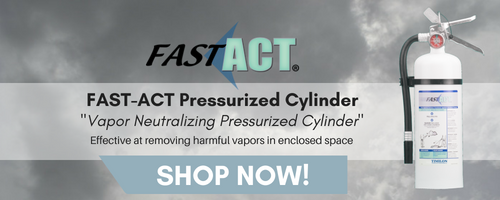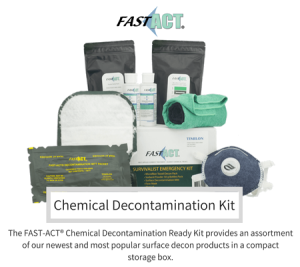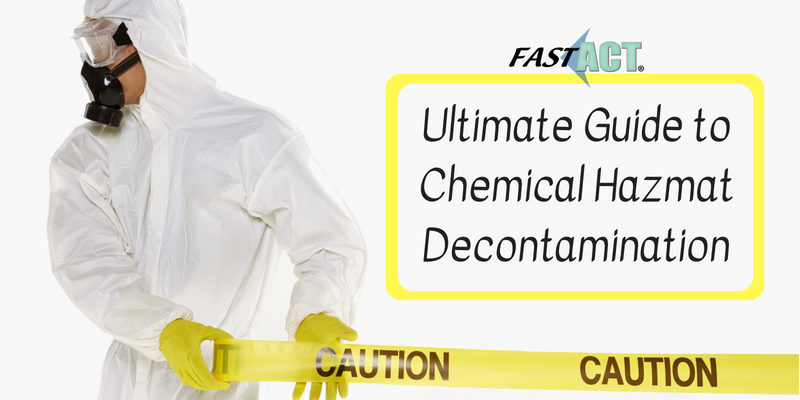What are the procedures or steps to take when a chemical has been released into your environment? Something that most emergency departments, emergency medical services (EMS) and even the military are armed with is both the knowledge and the equipment to have the ability to decontaminate such instances of chemical releases. Chemical releases can occur from terrorist attacks, chemical spills, or even chemical accidents in the workplace. The slight possibility of a chemical release requires those emergency responders & HAZMAT to be prepared for such an event with a decontamination plan. There are tailored training classes and programs geared to teaching the necessary decontamination training needed for chemical releases – including the necessary hazmat equipment desired to decontaminate the released chemical. Therefore, understanding what decontamination is and what hazmat decontamination equipment and procedures are required to accomplish the potential chemical contamination is grave to overall safety and health.
 What Does Decontamination Mean
What Does Decontamination Mean
Decontamination is the process of removing, reducing, or neutralizing contaminants that have accumulated on personnel, equipment and in the environment – it is critical to health and safety in hazardous conditions. Decon is a vital component to hazardous emergency response, as time becomes of the essence when dealing with a chemical release or attack. The process of decontamination is so important that, in many cases, no one is permitted to enter a hazardous area until decon is set up and ready to implement. However, sometimes containing a hazardous environment or area can be difficult, particularly when you are left dealing with the aftermath of a terrorist attack that released chemicals into a large populated area. Thus, the importance of decontamination is critical to public health and safety.
Importance of Decontamination
Every day, there are large quantities of hazardous chemicals that are created, transported, stored, and even applied for industrial or household purposes. While keeping in mind other potential threats like opposing countries that have stockpiles of chemical weapons that could be deployed unknowingly into the environment. Therefore, the importance of decontamination is high as proper decontamination practices can help aid in the reduction of hazardous chemicals, thus protecting health and ensuring safety in the environment. Chemicals can settle onto the surfaces and contaminate the area, therefore releasing airborne chemical, biological, radiological, and nuclear (CBRN) agents into the air. When these chemicals become airborne into the air, the risk of exposure increases for those in the environment which leads to the need for emergency responders and military members to quickly react to the chemical in the area, by utilizing a decontamination plan and chemical decontamination applications.
When chemicals are released into the environment, they can quickly spread throughout the infected area and reach for pass the deployed space. Three areas to monitor for contamination of chemicals includes surfaces, air, and on your skin.
Chemical Contamination on Skin
Chemical contamination on your skin will require almost immediate action. To start, you will quickly want to remove your clothing, as clothing can contribute to contamination and contact to your skin because the chemicals can become absorbed into the fabric of your clothing. Also, you will want to remove hazardous skin and hair from your skin with any dry absorbent material and follow with a wet decontamination – shower, swimming pool, etc.- to aid in the removal process.
Chemical Contamination on Surfaces
Chemical agents will disperse into the environment and begin settling onto the surfaces. When chemicals proceed to contaminate the surfaces, having a successful and effective decontamination solution is imperative to complete decontamination. Particularly, when dealing with Chemical Warfare Agents (CWAs) the difficulty in completely neutralizing and decontaminating the toxic chemical can be no easy task. Utilizing a surface decontamination application such as those of FAST-ACT can help to rid the surface of potentially hazardous chemicals that people can become exposed to and come into contact with.
 Chemical Contamination in the Air
Chemical Contamination in the Air
Vapor chemical releases that find their way into the air can become potentially toxic depending on the chemical at play and the quantity of the chemical in the air. Chemical exposure can occur when you breathe in air that is contaminated by hazardous chemicals that have circulated in the air. A chemical vapor release can be difficult to decontaminate and control as it can quickly make a significant impact on public health and safety. To effectively neutralize and decontaminate the hazardous chemical vapors you will need a vapor neutralizing pressurized cylinder that can work to decontaminate the sources of toxic vapor.
Types of Decontamination
There are a couple different methods for decontamination that first-responders, HAZMAT, and the military utilize. These different types of decontamination include water/soap wash, oxidation/hydrolysis, and hydrolysis. Going through each of these types of decontamination will help to determine the necessary chemical hazmat decontamination you will need for each chemical contamination situation.
Chemical Decontamination for Skin: Water/Soap Wash
Can soap and water do the trick for complete chemical decontamination on your skin? For a quick and immediate response to a chemical release, soap and water might be the quickest solution within reach. Soap and water is a low-cost decontaminant that removes chemicals by washing them off the skin. In most cases, large amounts of water or soap and water are effective for washing most agents including chemical, biological, and radiological contaminants.
 Chemical Decontamination for Surface: FAST-ACT Chemical Decontamination Kit
Chemical Decontamination for Surface: FAST-ACT Chemical Decontamination Kit
Surfaces, following a chemical release, can become contaminated and therefore create a hazardous environment for those exposed. Combating chemicals on the surface will require effective chemical neutralizing applications such as the FAST-ACT Chemical Decontamination Kit. The effective FAST-ACT Chemical Decon Kit provides an assortment of popular surface decon products all contained in a compact storage box. These surface decon products all utilize the proprietary FAST-ACT technology for neutralizing and decontaminating a broad spectrum of chemical agents. FAST-ACT contains a proprietary formulation of non-toxic high-performance specialty materials that are effective at broad spectrum chemical neutralization including chemical warfare agent neutralization. Included in the FAST-ACT Chemical Decontamination Kit is the following:
- FAST-ACT Decon Mitt (4 Mitts): Allows for safe and easy wiping and handling of chemical spills. Simply secure the mitt on your hand and apply to the contaminated surface.
- FAST-ACT Sorbent Powder Bottle Set: Two 50-gram proofer bottles of FAST-ACT. Just tear, open the pack, flip open the bottle top, aim and squeeze on the surface contamination.
- FAST-ACT Microfiber Towel Set: 2 microfiber towels, just open the pack, unroll towels, and use the green towel to absorb the excess liquid chemical from the surface, then use the FAST-ACT containing towel for surface chemical decontamination.
- FAST-ACT/ VapourKlenz Face Masks (3): Offers our patented neutralization technology in a comfortable face mask for nuisance particulates and chemical odors.
Chemical Decontamination for Air: FAST-ACT Pressurized Cylinder
Whether you are dealing with a chemical release, spill, or attack, the chemical(s) can become airborne in your environment, tainting the quality of your air and increasing your risk of danger. When hazardous chemicals are in your air it increases the risk of inhalation and exposure, therefore having a vapor chemical decontamination application is imperative to control the safety of the environment and those exposed. The FAST-ACT Pressurized Cylinder is a vapor chemical decontamination product contained in an extinguisher for easy release. This vapor decontamination application is effective at removing harmful vapors in an enclosed space and can also be used to decontaminate gear, vehicles, or vapors in the air.



